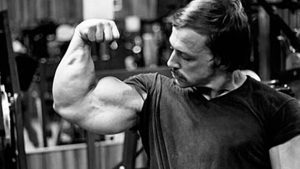Today I want to provide an intro to HIT (High Intensity Training) which is an effective form of weight training that was popular from the 1970s-1990s. It works just as well today as it did back then, but not a lot of lifters today know about it. It’s especially great if you’re short on time, if you’re lifting to supplement a sport, or if you just need a change of pace.
What the heck is HIT and who invented it?
The father of HIT is Arthur Jones, also the founder of Nautilus exercise equipment, who popularized it in the 1970’s. Jones made some basic observations like the legs of sprinters are bigger and more muscular than those of long distance runners and conjectured that brief high intensity exercise builds more muscle than long duration low intensity exercise. He did his research and eventually came up with a workout program that involves training 2 or 3 days per week, full body 30 minute sessions, doing 10-15 exercises, for 1 set of 8-20 reps to failure with as little rest as possible between exercises. The last point is the key to the routine. You only do one set of each exercise, but you go absolutely all out on that set until you fail to perform a rep in good form. The idea is that the last couple of reps where you’re straining with all of your might are the ones that will trigger a stress response in your body and cause it to adapt by growing bigger and stronger.
Does it work?
In Jones’ famous “Colorado experiment”, he took bodybuilder Casey Viator through 4 weeks of HIT workouts, and the result was a gain of 63 pounds of muscle in those 28 days. It sounds unbelievable, but it’s a documented experiment. Keep in mind that most of the weight gain was muscle regained after a period of not training, so you can’t expect to gain that much yourself, but it’s still an incredible result. Viator went on to win the Mr. America bodybuilding contest.

Another famous proponent of HIT is Dr. Ken Leistner, a trainer from Long Island, New York. Dr. Ken has trained a number of top powerlifters, NFL players, and Olympic track athletes using HIT workouts. To give an example of what this type of training can do, Dr. Ken once posted a video of himself at 53 years old and 160 pounds squatting 407 pounds for 23 repetitions! He claimed that his son Kevin Tolbert, a football player who also trained using HIT, once squatted 600 pounds for 30 repetitions – both feats almost beyond belief!

Example Workouts
Here’s one of Arthur Jones’ HIT workouts, taken from the Colorado experiment:
Leg Press – 1 x 20
Leg Extension – 1 x 20
Squat – 1 x 15
Leg Curl – 1 x 10
Calf Raise – 1 x 15
Pullover – 1 x 10
Row Machine – 1 x 10
Behind-the-neck Lat Pull-downs -1 x 10
Straight-armed Lateral Raise with Dumbbells – 1 x 10
Behind-the-neck Shoulder Press – 1 x 8
Bicep Curl – 1 x 8 reps
Chin-ups – 1 x max reps
Tricep Extension – 1 x 10
Parallel Dip – 1 x max reps
Here’s one of Dr. Ken’s workout programs:
DAY ONE
Squat – 1 x 20 (rest 3 minutes)
Squat – 1 x 10-12
Stiff-legged Deadlift – 1 x 15
Pullover – 1×12
Pulldown – 1 x 8
Shrug – 1 x 15
Pullover – 1 x 9-10
Row – 1 x 10
Shrug – 1 x 10
Leg Press – 1 x 30
Side Bend – 15 each side
DAY TWO
Bench Press – 1 x 12
Upright Row – 1 x 8
Bench Press – 1 x 6-8
Barbell Curl – 1 x 12
Lateral Raise – 1 x 8
Front Raise – 1 x 6
Dip – 1 x 10
Barbell Curl – 1 x 8
Dip – 1 x 8
Standing Calf Raise – 1 x 20; 1 x 10
Seated Calf Raise – 1 x 15
The number of reps listed above are just guidelines… remember the key is to do as many reps as you possibly can with the weight that you selected. You may also notice that Jones’ workout incorporates pre-exhaustion, for example leg extensions before squats and lateral raises before shoulder presses, to throw more stress on the target muscles during the big compound lifts.
Jones and Dr. Ken both emphasized that higher intensity = better results and that the last gut-busting rep of each set is the key to growth, so to make this really work you need to keep pushing each set as if your life depended on getting one more rep. It ain’t easy, but nothing worthwhile ever is! You’ll need a spotter on some of the exercises to pull the weight off you when you get stuck. Rest between exercises should be 60 seconds or less.
Is HIT training for you?
If you like the idea of serious muscular gains from just 90 minutes of intense exercise per week instead of the more typical 4-6 hours per week, then HIT might be for you. It’s also a good way to supplement a sport because it leaves you more time to practice the sport itself. Just keep in mind that going to complete muscular failure on compound exercises like squats and deadlifts is a brutal way to train and has some inherent risk to it. Make sure your form is solid on those lifts before you attempt going to failure on them, and stop immediately if you feel your form breaking down. If you can summon the proper intensity, HIT definitely works, but it takes its toll on both body and mind. I recommend training this way for only 6-8 weeks at a time before switching to something more moderate to give yourself a break.
Let me know how it goes and post below if you have any questions or comments!


